Institutional Revolutionary Party
The Institutional Revolutionary Party (Spanish: Partido Revolucionario Institucional, PRI) is a Mexican political party founded in 1929 that held uninterrupted power in the country for 71 years from 1929 to 2000, first as the National Revolutionary Party (Spanish: Partido Nacional Revolucionario, PNR), then as the Party of the Mexican Revolution (Spanish: Partido de la Revolución Mexicana, PRM) and finally as the PRI beginning in 1946.
Institutional Revolutionary Party Partido Revolucionario Institucional | |
|---|---|
.svg.png) | |
| President | Alejandro Moreno Cárdenas |
| Secretary-General | Carolina Viggiano Austria |
| Founded | 4 March 1929 (as PNR) 30 March 1938 (as PRM) 18 January 1946 (as PRI) |
| Headquarters | Av. Insurgentes Norte 59 col. Buenavista 06359 Cuauhtémoc, Mexico City |
| Newspaper | La República |
| Youth wing | Red Jóvenes x México |
| Labor wing | Confederation of Mexican Workers |
| Ideology | Revolutionary nationalism[1][2][3] Constitutionalism[4][5][6] Social conservatism[7][8][9] Technocracy[10] Big tent[11][12] |
| Political position | Centre[13][14][15] |
| National affiliation | Todos por México |
| Continental affiliation | COPPPAL |
| International affiliation | Socialist International[16] |
| Colors | Green, white, and red |
| Seats in the Chamber of Deputies | 47 / 500 |
| Seats in the Senate | 14 / 128 |
| Governorships | 12 / 32 |
| Seats in State legislatures | 184 / 1,123 |
| Website | |
| pri | |
The PNR was founded in 1929 by Plutarco Elías Calles, Mexico's paramount leader at the time and self-proclaimed Jefe Máximo (Supreme Chief) of the Mexican Revolution. The party was created with the intent of providing a political space in which all the surviving leaders and combatants of the Mexican Revolution could participate and to solve the severe political crisis caused by the assassination of President-elect Álvaro Obregón in 1928. Although Calles himself fell into political disgrace and was exiled in 1936, the party continued ruling Mexico until 2000, changing names twice until it became the PRI.
The PRI maintained absolute power over the country for most of the twentieth century: besides holding the Presidency of the Republic, until 1976 all members of the Senate belonged to the PRI, while all of the State Governors were also from the PRI until 1989. Throughout the seven decades that the PRI governed Mexico, the party used a combination of corporatism, co-option and (at many times, violent) repression to hold power, while usually resorting to electoral fraud when these measures were not enough. In particular, the presidential elections of 1940, 1952 and 1988 were characterized by massive irregularities and fraudulent practices denounced by both domestic and international observers. While during the early decades of PRI rule Mexico benefited from an economic boom which improved the quality of life of most people and guaranteed political and social stability, issues such as inequality, corruption and the lack of democracy and political freedoms cultivated growing resentment against the PRI, culminating in the 1968 Tlatelolco massacre in which the Army killed hundreds of unarmed student demonstrators. In addition, a series of economic crises beginning in the 70s drastically lowered the living standards of the population.
Throughout its nine-decade existence, the party has adopted a very wide array of ideologies (often determined by the President of the Republic in turn). In the 1980s, the party went through reforms that shaped its current incarnation, with policies characterized as centre-right such as the privatization of state-run companies, closer relations with the Catholic Church and embracing free-market capitalism.[17][18][19] At the same time, the left-wing members of the party abandoned the PRI and founded the Party of the Democratic Revolution (Partido de la Revolución Democrática, PRD) in 1989.
In 1990, Peruvian writer Mario Vargas Llosa famously described Mexico under the PRI regime as being "the perfect dictatorship", stating: "I don't believe that there has been in Latin America any case of a system of dictatorship which has so efficiently recruited the intellectual milieu, bribing it with great subtlety. The perfect dictatorship is not communism, nor the USSR, nor Fidel Castro; the perfect dictatorship is Mexico. Because it is a camouflaged dictatorship."[20][21] The phrase became popular in Mexico and internationally, until the PRI fell from power in 2000.
After losing the Presidency in the 2000 elections, the PRI held most of the state governments and had strong performances at the local levels; nonetheless, in the 2006 Presidential elections the PRI's performance was the worst of its history up to that point, with its candidate Roberto Madrazo finishing in third place and having failed to carry a single state. In spite of this defeat, the PRI continued to perform strongly at Municipal and State levels. As a result, the PRI won the 2009 legislative election, and in 2012 it regained the Presidency after winning the elections of that year with Enrique Peña Nieto as candidate. However, massive dissatisfaction with Peña Nieto's administration as a result of numerous corruption scandals and the government's inability to curb the crime rate led to the PRI losing the Presidency once more in the 2018 elections (the PRI candidate in these elections was José Antonio Meade), with a performance even worse than that of 2006.
Overview
Profile
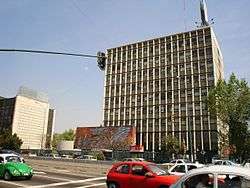
The adherents of the PRI are known in Mexico as Priístas and the party is nicknamed El tricolor (Tricolor) because of its use of the Mexican national colors of green, white and red as found on the Mexican flag.
The PRI is described by some scholars as a "state party",[18][22] a term which captures both the non-competitive history and character of the party itself, and the inextricable connection between the party and the Mexican nation-state for much of the 20th century.
According to the Statesman Journal, for more than seven decades, the PRI ran Mexico under an "autocratic, endemically corrupt, crony-ridden government". The elites of the PRI ruled the police and the judicial system, and justice was only available if purchased with bribes.[23] During its time in power, the PRI became a symbol of corruption, repression, economic mismanagement, and electoral fraud; many educated Mexicans and urban dwellers worried that its return could signify a return to Mexico's past.[24]
Although it is a full member of the Socialist International along with its rival, the left-wing PRD (this makes Mexico one of the few nations with two major, competing parties that are part of the same international grouping),[16] the PRI is not considered a social democratic party in the traditional sense.
Etymology
At first glance, the PRI's name looks like a confusing oxymoron or paradox to speakers of English, for they normally associate the term "revolution" with the destruction of "institutions".[25] As Rubén Gallo contends, the Mexican concept of institutionalizing the Revolution simply refers to the corporatist nature of the party, that is, the PRI subsumed the "disruptive energy" of the Revolution (and thereby ensured its own longevity) by co-opting and incorporating its enemies into its bureaucratic government as new institutional sectors.[25]
Party practices
There is a lexicon of terms used to describe people and practices of the PRI, that were fully operative until the 1990s. The most important was the dedazo, with the finger (“dedo”) of the President pointing to the PRI candidate for the presidency, meaning the president choosing his successor. Right up until the moment the President considered optimal, several pre-candidates would attempt to demonstrate their loyalty to the President and their high competence in their position, usually as high cabinet members. Until the 2000 election, the party had no direct input into the President's decision, although he could consult with constituencies. The president's decision was a closely kept secret, even from the victor.
The "destape" (the unveiling), that is, the announcement of the President's choice, would take place at the PRI's National Assembly (which would typically take place in November of the year previous to the elections), with losing pre-candidates learning only then themselves.[26] Once the destape occurred, in general the members of the PRI would demonstrate their enthusiasm for the candidate and their loyalty to the party, known as the cargada. But the destape was also a delicate moment since party unity depended on the losers acceding to the president's choice without public rancor or dissent. When Miguel de la Madrid (1982–1988) chose Carlos Salinas de Gortari as the candidate in 1988, Cuauhtémoc Cárdenas and Porfirio Muñoz Ledo left the PRI to form a separate party, and Cárdenas challenged Salinas at the polls (The 1988 presidential elections are widely considered to have been fraudulent)[27].
The term alquimistas ("alchemists") referred to PRI specialists in vote-rigging. To achieve a complete sweep of elections, the carro completo (“full car”), the party used the campaign mechanism of the acarreo (“hauling”), the practice of trucking PRI supporters to rallies to cheer the candidate and to polling places to vote for them in exchange for gifts of some kind.[28]
Presidential succession before the party, 1920–1928
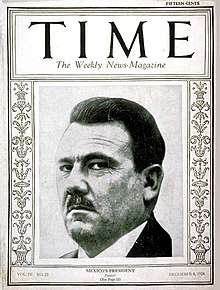
When it was founded in 1929, the party structure created a means to control political power and to perpetuate it with regular elections validating the party's choice. Before the party was founded, political parties were not generally the means in which to achieve the presidency. The creation of the party in the wake of the assassination of revolutionary general, former president, and in 1928 president-elect Alvaro Obregón had laid bare the problem of presidential succession with no institutional structures. Obregón was one of three revolutionary generals from Sonora, with Plutarco Elías Calles and Adolfo de la Huerta, who were important for the post-revolutionary history of Mexico. Their collective and then internecine struggles for power in the decade after the end of the military phase of the Mexican Revolution had a direct impact on the formation of the party in 1929.
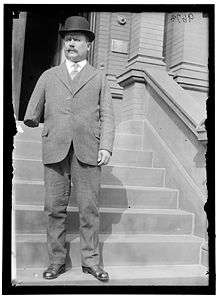
In 1920, the Sonorans staged a coup against President Venustiano Carranza, the civilian First Chief of the Constitutionalist faction that had won the Mexican Revolution. Carranza had attempted to impose his own candidate for the presidency, Ignacio Bonillas. Bonillas had zero revolutionary credentials and no power base of his own, with the implication that Carranza intended to hold onto power after the end of his term. This would have been a violation of the no re-election principle of post-revolutionary Mexico, which had its origins in the 19th century. With the support of the revolutionary army, the Sonoran generals' Plan of Agua Prieta successfully challenged Carranza's attempt to perpetuate his power; Carranza was killed as he was fleeing the country. De la Huerta became interim president of Mexico and Obregón was elected president for a four-year term, 1920–1924.
As Obregón's four-year term was ending, Calles bid for the presidency. Fellow Sonoran De la Huerta challenged Calles in a massive and bloody uprising, supported by other revolutionary generals opposed to Calles. The De la Huerta rebellion was crushed, but the outbreak of violence was only a few years after the apparent end of the Mexican Revolution, raising the specter of renewed violence.[29] Calles succeeded Obregón in 1924, and shortly thereafter he began enforcing the restrictions on the Catholic Church in the 1917 Constitution, resulting in a huge rebellion by those opposed to such restrictions, known as the Cristero War (1926–29). The Cristero War was ongoing when elections were to be held.
Obregón sought to run again for the presidency in 1928 to succeed Calles, but because of the principle of no-reelection in the Mexican Constitution, the two Sonorans sought a loophole to allow the former president to run. The Constitution was amended to allow re-election if the terms were not consecutive. With that change, Obregón ran for the 1928 election and won. But before his inauguration he was assassinated by a religious fanatic. Since Calles had just served as president, even with the constitutional change to allow a form of re-election, he was ineligible to run. The founding of a national political party that had an existence beyond elections became the mechanism to control power through peaceful means.
Founding of the Party
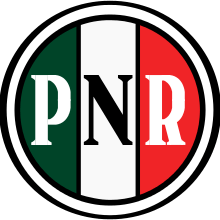

The political party had two previous names before taking its third and current name, but its core has remained the same. It has been characterized as a "in the 1960s as 'strongly dominant party', in the 1970s a 'pragmatic hegemonic state', and in the 1990s as a 'single party'".[30] The close relationship between the PRI and the Mexican state has been examined by a number of scholars.[31][32]
PNR (1929–1938)
"Today we have the chance, unique in many years, to go from the category of a country of caudillos, to a Nation of Institutions." - Plutarco Elías Calles, during his last Address to the Congress on 1 September 1928.[33]
Even though the armed phase of the Mexican Revolution had ended in 1920, Mexico continued to encounter political unrest. A grave political crisis caused by the July 1928 assassination of president-elect Álvaro Obregón led to the founding on 4 March 1929 of the National Revolutionary Party (Spanish: Partido Nacional Revolucionario, PNR) by Plutarco Elías Calles, Mexico's president from 1924 to 1928. Emilio Portes Gil was interim president of Mexico from December 1928 until February 1929, while a political rather than military solution was sought for presidential succession.
The intent to found the party was to institutionalize the power of particular victors of Mexican Revolution. Calles was ineligible to run for president, since he had just completed a four-year term, because of the prohibition in the 1917 Constitution of re-election directly after serving a term as president. Calles sought to stop the violent struggle for power between the victorious factions of the Revolution, particularly around the presidential elections and to guarantee the peaceful transmission of power for members of the party. A conclave of revolutionary generals including Calles met to create a national party, forging together their various regional strongholds. They were not primarily concerned with ideology, but rather to hold power.[34][35] Formally, the PNR was a political party, but it has been labeled a "confederation of caciques" ("political bosses").[36]
The new party-in-formation did not contain any labor elements. At the time, the strongest labor organization was the Regional Confederation of Mexican Workers (CROM) controlled by Luis N. Morones. CROM had a political wing, the Laborist Party. Calles went to the Laborist Party convention and addressed the membership in a conciliatory fashion, but Morones launched into a diatribe against Emilio Portes Gil, the interim president of Mexico, for disrepecting Morones personally. It was a political gaffe for Calles, and he withdrew from the organizing committee of the party, but he turned it to his advantage in the long run, appearing to be a referee or arbiter in the party, and impartial senior statesman.[37]
.jpg)
The PNR incorporated other political parties under its umbrella, the Partido Radical Tabasqueño, of Tomás Garrido Canabal; the Yucatán-based Partido Socialists del Sureste, of Felipe Carrillo Puerto; and the Partido Socialista Fronterizo of Emilio Portes Gil, the current interim president. CROM's political arm, the Laborist Party, was not part of the coalition.[38] The party developed a written set of principles and a platform that drew support from agraristas and workers in the Laborist Party. "The PNR is the instrument of political action by means of which Mexico's great campesino and worker masses fight to keep control of the public power in their hands, a control wrested from the landowning and privileged minorities through the great armed movement that began in 1910."[39]
One possible presidential candidate for the PNR was Aarón Sáenz Garza, former governor of the state of Nuevo León, who was the brother-in-law of Calles's son, and was involved with Calles family businesses, but his political views were too far to the right of the PNR to be considered. Ideology trumped family connections. The choice fell to Pascual Ortiz Rubio, a revolutionary general who had been out the country, serving as Mexico's ambassador to Brazil, so had no political base in Mexico.[40]
When the 1929 Mexican general election was held, the first political test of the newly founded party. Calles made a speech in June 1929 saying that while the Revolution had produced achievements in the economic and social spheres that in the political sphere it was a failure. He called for a "struggle of ideas" that invited the formation of new parties. The PNR had as its candidate Pascual Ortiz Rubio, but running against him as the candidate for the Anti-Reelectionist Party was the high-profile former Secretary of Education, José Vasconcelos. Vasconcelos had considerable support among university students, the middle class, intellectuals, and some workers from Mexico's northeast. According to historian Enrique Krauze, the 1929 campaign saw the PNR's "initiation into the technology of electoral fraud, a 'science' that later became its highly refined speciality." Tactics included breaking up political meetings and insults, to the extreme of murder of Vasconcelos supporters. Ortiz Rubio won the election in a landslide, but the results would likely have been different were the election clean. The party did largely contain the political violence of former revolutionary generals.[41]
In the first years of the party's existence, the PNR was the only political machine in existence. During this period, known as Maximato (named after the title Calles gave himself as "Maximum Chief of the Revolution"), Calles remained the dominant leader of the country and Ortiz Rubio (1929–32) and Abelardo L. Rodríguez (1932-34), have been considered in practice subordinates of Calles.
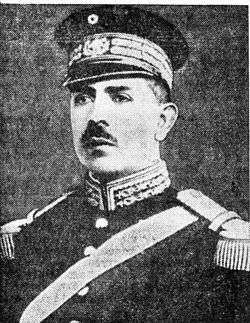
Calles chose revolutionary general Lázaro Cárdenas as his successor.[42] Cárdenas was originally from the southern state of Michoacan, but he joined the Revolution in the north, serving with Calles. The Jefe Máximo had no idea that Cárdenas would take his own path as he settled into the presidency. He had campaigned widely throughout the country, making a national reputation for himself and forming personal connections throughout the country outside the corridors of power. Calles had become increasingly conservative in his views, ending land reform for all practical purposes and cracking down on organized labor. Under Cárdenas, unions went on strike, which were not suppressed by the government. As Cárdenas increasingly diverged in his thinking and practice from Calles, Calles sought to regain control. Cárdenas, however, had outmaneuvered Calles politically, gaining allies among labor unions and peasants, as well as the Catholic Church. Calles had attempted to strictly enforce the anticlerical provisions of the Constitution, which led directly to conflict with the Catholic Church and its loyalists, so that in the conflict between the two generals, the Church sided with Cárdenas. Cárdenas had Calles arrested along with many of his allies, exiling Calles to the United States.
PRM (1938–1946)

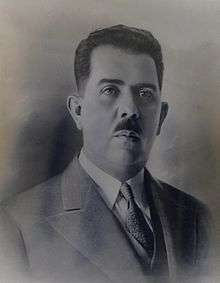
Cárdenas became perhaps Mexico's most popular 20th-century president, most renowned for the 1938 expropriating the oil interests of the United States and European petroleum companies in the run-up to World War II. That same year Cárdenas put his own stamp on the party, reorganizing it in 1938 as the Party of the Mexican Revolution (Spanish: Partido de la Revolución Mexicana, PRM) whose aim was to establish a democracy of workers and socialism.[43] However, this was never achieved.
Cárdenas's intention was to establish the broad-based political alliances necessary for the party's long-term survival, as a national party with territorial presence in state and municipal governments, and organization of mass interest groups, via corporatism. The structure he established has remained intact. He created sectors of the party and structured them into mass organizations to represent different interest groups within the party, to protect the interests of workers and peasants.[44]
The PRM had four sectors: labor, peasant (campesino), "popular", mainly teachers and civil servants; and the military. The labor section was organized via the Confederation of Mexican Workers (CTM); the peasant sector by the National Confederation of Campesinos, (CNC); and the middle class sector by the Federation of Unions of Workers in Service to the State (FSTSE).[45] The party incorporated the majority of Mexicans through their mass organizations, but absent from the structure for ideological reasons were two important groups, private business interests and adherents of the Catholic Church.[46] Those two came together in 1939 to form the National Action Party, which grew to be the major opposition party, winning the presidency in 2000.
The most powerful labor union prior to the formation of the party was the Regional Confederation of Mexican Workers (CROM), headed by Luis N. Morones, an ally of Obregón and Calles.[47] A dissident within the CROM, Marxist Vicente Lombardo Toledano, formed a rival labor confederation, the CTM in 1936, which became the mass organization of labor within the PRM.[48] Lombardo stepped down from the leadership of the CTM in 1941, after Cárdenas left the presidency. He was replaced by Fidel Velázquez, who remained head of the CTM until his death at age 97.[49] Within the party structure and the government, labor has had a continuous, formalized, visual corporate role, but with Velazquez's death in 1997, organized labor has fractured.[50]
Peasants were organized via the Confederación Nacional Campesina (CNC), or National Peasant Confederation, which Cárdenas saw as a force against landowners, but it became the vehicle for patron-client / state-campesino relationships. Whether the intention or not of Cárdenas, the CNC became a means to channel and control the peasantry.[51]
The so-called "popular" sector of the party was organized via the Confederación Nacional de Organizaciones Populares (CNOP), which was formed in 1943 to integrate sectors of the urban middle class into the party. Unlike the peasantry or labor, the popular sector was a more ill-defined segment, but it did include the large Federation of Unions of Civil Servants (Federación de Sindicatos de Trabajadores al Servicio del Estado (FSTSE).[52]
By incorporating the military into the PRM structure, Cárdenas's aim was to make it politically dependent on the party rather than allow it to be a separate group outside the party and potentially a politically interventionist force. Although some critics questioned the military's incorporation into the party, Cárdenas saw it as a way to assert civilian control. He is quoted as saying, “We did not put the Army in politics. It was already there. In fact it had been dominating the situation, and we did well to reduce its voice to one in four.”[53] In general, the corporatist model is most often associated with fascism, whose rise in Germany and Italy in the 1930s coincided with Cárdenas's presidency.
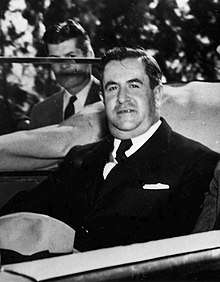
But Cárdenas was emphatically opposed to fascism; however, he created the PRM and organized the Mexican state on authoritarian lines. That reorganization can be seen as the enduring legacy of the Cárdenas presidency. Although the PRM was reorganized into the Institutional Revolutionary Party in 1946, the basic structure was retained. Cárdenas's calculation that the military's incorporation into the PRM would undermine its power was essentially correct, since it disappeared as a separate sector of the party, but was absorbed into the “popular” sector.[54] The organizational change in the PNR to the PRM, and later the PRM to the PRI, were "imposed by Mexican presidents without any discussion within the party."[55]
Cárdenas followed the pattern of Calles and Obregón before him, designating his choice in the upcoming elections; for Cárdenas this was Manuel Avila Camacho. In the 1940 election, Avila Camacho's main rival was former revolutionary general Juan Andreu Almazán, with PRM victory coming via fraud after a violent campaign period.Cárdenas is said to have secured the support of the CTM and the CNC for Ávila Camacho by personally guaranteeing their interests would be respected.[56]
In the final year of Avila Camacho's term the party assembly decided on a new name, pushed by the circle of Miguel Alemán, the Institutional Revolutionary Party, pairing seemingly contradictory terms of "institutional" and "revolutionary."[55]
PRI (1946–1988)
Change in structure and ideology
| ||||||||
The party's name was changed in 1946, the final year of Manuel Ávila Camacho's term of office.[57] The sectoral representation in the party continued for the workers, peasants, and the popular sector, but the military was no longer represented by its own sector. The Mexican president was at the apex of the political system with the PRI. To reach the top of the government, as the candidate and then president of the republic, the path was only through membership and leadership in the party and government service. Within the party, there were factions, the técnicos, bureaucrats with specialized knowledge and training, especially with the economy, and políticos, the seasoned politicians, many of whom had regional roots in state politics.[58]
Miguel Alemán was the PRI's candidate in the 1946 elections, but he did not run unopposed. Alemán and his circle had hoped to abandon sectoral representation in the party and separate the party as an organism of the state, but there was considerable pushback from the labor sector and the CTM, which would have lost influence, along with the other sectors. The structure of the party remained sectoral, but the Alemanistas abandoned the goal that had been "the preparation of the people for the implementation of a workers' democracy and for the arrival of a socialist regime."[59] The party slogan was changed from the PRM's "For a workers' democracy" (Por una democracia de trabajadores) to the PRI's "Democracy and justice" (Democracia y justicia).
In practice after Cárdenas left office, the party became more centrist, and his more radical agrarian policies were abandoned.[60] With Lombardo Toledano's replacement as leader of the CTM, labor under the CTM's Fidel Velázquez became even more closely identified with the party. The more radical left of the labor movement, under Vicente Lombardo Toledano, split from the PRI, the Partido Popular. Although the party gave voice to workers' demands, since it was outside the umbrella of the PRI and lost power and influence.[61] The leadership of component unions became advocates of PRI policy at the expense of the rank and file in exchange for political backing from the party and financial benefits. These charro ("cowboy") unions turned out the labor vote at election time, a guaranteed base of support for the party. During prosperous years, CTM could argue for benefits of the rank-and-file, such as higher wages, networking to provide jobs for union loyalists, and job security. The principle of no-reelection did not apply to the CTM, so that the party loyalist Velázquez provided decades of continuity even as the presidency changed every six years.[62]
The PRI won every presidential election from 1929 to 1982, by well over 70 percent of the vote—margins that were usually obtained by massive electoral frauds. Toward the end of his term, the incumbent president in consultation with party leaders, selected the PRI's candidate in the next election in a procedure known as "the tap of the finger" (Spanish: el dedazo), which was integral in the continued success of the PRI towards the end of the 20th century. In essence, given the PRI's overwhelming dominance, and its control of the electoral apparatus, the president chose his successor. The PRI's dominance was near-absolute at all other levels as well. It held an overwhelming majority in the Chamber of Deputies, as well as every seat in the Senate and every state governorship.
The political stability and economic prosperity in the late 1940s and the 1950s benefited the party, so that in general Mexicans did not object to the lack of real democracy.
Mexican Miracle
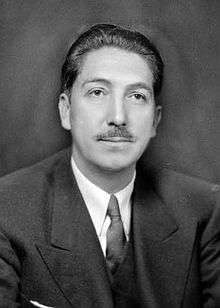
Starting with the Alemán administration (1946–1952) until 1970, Mexico embarked on a sustained period of economic growth, dubbed the Mexican Miracle, fueled by import substitution and low inflation. From 1940 to 1970 GDP increased sixfold while the population only doubled,[63] and peso-dollar parity was maintained at a stable exchange rate.
Economic nationalist and protectionist policies implemented in the 1930s effectively closed off Mexico to foreign trade and speculation, so that the economy was fueled primarily by state investment and businesses were heavily reliant on government contracts. As a result of these policies, Mexico's capitalist impulses were channeled into massive industrial development and social welfare programs, which helped to urbanize the mostly-agrarian country, funded generous welfare subsidies for the working class, and fueled considerable advances in communication and transportation infrastructure. This period of commercial growth created a significant urban middle class of white-collar bureaucrats and office workers, and allowed high-ranking PRI officials to graft large personal fortunes through their control over state-funded programs. State monopoly over key industries like electricity and telecommunication allowed a small clique of businessmen to dominate their sectors of the economy by supplying government-owned companies with goods and commodities.
A major impact of Mexico's economic growth was urban population growth, transforming the country from a largely rural one to urban. The middle class grew substantially. The overall population of Mexico grew substantially with a greater proportion being under the age of 16. These factors combined to decrease the pull of the past. The policies promoting industrial growth helped fuel the growth of Mexico's north as a center of economic dynamism, with the city of Monterrey becoming Mexico's second largest.[64]
The general economic prosperity served to legitimize PRI hegemony in the eyes of most Mexicans, and for decades the party faced no real opposition on any level of government. On the rare occasions when an opposition candidate, usually from the conservative National Action Party, whose strength was in Mexico's north, garnered a majority of votes in an election. The PRI often used its control of local government to rig election results in its favor. Voter apathy was characteristic in this period, with low turnout in elections.[65] The PRI co-opted criticism by incorporating sectors of society into its hierarchy. PRI-controlled labor unions, ("charro unions") maintained a tight grip over the working classes; the PRI held rural farmers in check through its control of the ejidos (state-owned plots of land that peasants could farm but not own), and generous financial support of universities and the arts ensured that most intellectuals rarely challenged the ideals of the Mexican Revolution. In this way, PRI rule was supported by a broad national consensus that held firm for decades, even as polarizing forces gradually worked to divide the nation in preparation for the crises of the 1970s and 80s.[66] The consensus specifically held that Mexico would be capitalist in its economic model; that the masses of workers and peasants would be kept in check—as separate units and not allowed to merge into a single sector that would have too much strength; that the state and the party would be the agent for this control; and that the state and private entrepreneurs would compete in the mixed economy.[67] So long as there was general prosperity, the system was stable economically and politically. Political balance meant that sectors had a voice within the party, but the party and the state were the arbiters of the system. Those supporting the system received material rewards that the state distributed. In this period, there was a continuing rapprochement with the United States, which built on their alliance in World War II. Although there was rhetoric about economic nationalism and defense of Mexican sovereignty, there was a broad based cooperation between the two countries.[68]
Cracks appeared in the system. There was significant labor unrest with strikes by railway workers, electricians, and even medical doctors that were brutally suppressed. Culturally the mood was changing as well, with Carlos Fuentes publishing The Death of Artemio Cruz (La Muerte de Artemio Cruz) in 1962, metaphorically the death of the ideals of the Mexican Revolution. The fictional Cruz had been a revolutionary soldier, corrupt politician, and businessman, now on his deathbed. Considered a landmark in Latin American literature, it highlighted aspects of Mexican history and its political system.[69]
Attempts at party reform
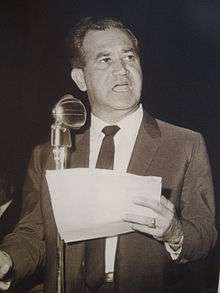
When Alemán became president in 1946, the PRI had begun experiments in internal primaries, but Alemán cracked down on this democratic opening and had congress pass a law against parties from holding primaries. President of the PRI, revolutionary general Rodolfo Sánchez Taboada had been in favor of primaries, but Alemán's viewpoint prevailed and PRI candidates were chosen in closed party assemblies. Sánchez was replaced as titular head of the party, and the president of the republic remained firmly in control.[70]
During the early presidency of Gustavo Díaz Ordaz, Carlos A. Madrazo was appointed president of the party and undertook serious reforms in 1964-65. PRI legislators were attempting to negate the principle of no-reelection for members of congress, which many of supported. Madrazo went further in reform attempts, seeking to democratize the electoral process for municipal candidates, which sectoral leaders and local PRI bossed opposed because it would undermine their hold on local elections. It was implemented in just seven states. Madrazo was forced to resign.[71] Madrazo died in an airplane crash in 1969, which at the time was considered suspicious.[72]
Only in 2000 did the PRI choose its presidential candidate through a primary, but its candidate Francisco Labastida lost that election.
Political impact of the 1968 Tlatelolco massacre
The improvement of the economy had a disparate impact in different social sectors and discontent started growing within the middle class as well as the popular classes. The doctors' strike in 1965 was a manifestation of middle class discontent. Seeking better wages and workplace conditions, doctors demanded redress from the government. Rather than give into such demands, President Díaz Ordaz sent in riot troops to suppress the strike with brute force and arrest leaders. Two hundred doctors were fired.[73] Díaz Ordaz's hard line on this strike by a sector of the middle class presaged even harsher suppression during the summer of 1968.
With the choice of capital for the venue for the 1968 Mexico City Olympic Games slated for October, the government poured huge resources into preparing facilities. Mexico wanted to showcase its economic achievements and sought the international focus on the country. Maintaining an image of a prosperous and well-ordered Mexico was important for the Mexican government. However, things began to go badly wrong. In a relatively low-level conflict in late July 1968 between young people in Mexico City, the Granadero riot police used violence to tamp down the incident. However, the crackdown had the opposite effect, with students at the National University (UNAM) and the National Polytechnic Institute (IPN) putting aside their traditional rivalries and joining together in protest in the Mexican Student Movement.
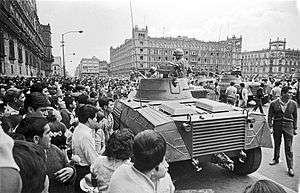
They protested lack of democracy and social justice in Mexico. Middle class university students had largely been apolitical up until this point. President Gustavo Díaz Ordaz (1964–1970) ordered the army to occupy the university to suppress the mobilization and minimize the disruption of the Olympic Games. Orderly large-scale protests in downtown Mexico City showed the discontent of students and their largely middle-class supporters.[74] As the opening ceremonies of the Olympics approached, the government sought help from the United States in dealing with the protests. Unaccustomed to this type of protest, the Mexican government made an unusual move by asking the United States for assistance, through LITEMPO, a spy-program to inform the Central Intelligence Agency (CIA) of the US to obtain information from Mexico. The CIA responded by sending military radios, weapons and ammunition.[75] The LITEMPO had previously provided the Díaz Ordaz government with 1,000 rounds of .223 Remington ammunition in 1963.[76]
After weeks of huge and largely peaceful demonstrations in Mexico City in August and September by students and middle class Mexicans, the government cracked down on October 2, with army and special tactical units opening fire on a relatively small demonstration in Tlatelolco, a section of the metropolis. They killed and wounded a large but unknown number of protesters. Despite that the Olympics went forward on schedule, with the President of the Olympic Committee declaring that the protests were against the Mexican government and not the Olympics themselves, so the games proceeded.[77]
Political life in Mexico was changed that day. October 2, 1968, the date of what is known as the Tlatelolco massacre, is a turning point in Mexican history. That date "marks a psychological departure in which Mexicans -- particularly urban, well-educated citizens, intellectuals, and even government officials themselves--began to question the efficiency and morality of an authoritarian state that required violence against middle-class students to maintain its position of authority and legitimacy to govern."[78] Intellectuals were alienated from the regime, after decades of cooperation with the government and receiving benefits for that service. The poet and essayist Octavio Paz, who would later win the Nobel Prize in Literature, resigned as Mexican Ambassador to India. Novelist Carlos Fuentes denounced the repression.[79][80]
Díaz Ordaz chose Luis Echeverría as the PRI candidate in the 1970 election. As the Minister of the Interior, Echeverría was operationally responsible for the Tlatelolco massacre.[81]
Economic crisis of the 1970s
By the early 1970s, fundamental issues were emerging in the industrial and agricultural sectors of Mexico's economy. Regional underdevelopment, technological shortages, lack of foreign competition, and uneven distribution of wealth led to chronic underproduction of investment and capital goods, putting the long-term future of Mexican industry in doubt. Meanwhile, ubiquitous poverty combined with a dearth of agricultural investment and infrastructure caused continuous migration from rural to urban areas; in 1971, Mexican agriculture was in such a state that the country had become a net importer of food. Overvaluation of the peso led to a decline in the tourism industry (which had previously compensated for failures in industry and agriculture) meant that by the early 1970s, the economy had begun to falter, and the only sure source of capital was external borrowing.[82]
Díaz Ordaz chose his Government Secretary, Luis Echeverría, to succeed him as President. Echeverría's administration (1970–76) increased social spending, through external debt, at a time when oil production and prices were surging. However, the growth of the economy came accompanied by inflation and then by a plummeting of oil prices and increases in interest rates. Investment started fleeing the country and the peso became overvalued, to prevent a devaluation and further fleeing of investments, the Bank of Mexico borrowed 360 million dollars from the Federal Reserve with the promise of stabilizing the economy. External debt reached the level of $25 billion.[83] Unable to contain the fleeing of dollars, Echeverría allowed the peso to float for the first time on August 31, 1976, then again later and the peso lost half of its value.[83] Echeverría designated José López Portillo, his Secretary of Finance, as his successor for the term 1976-82, hoping that the new administration would have a tighter control on inflation and to preserve political unity.[83]
Election of 1976, PRI runs unopposed
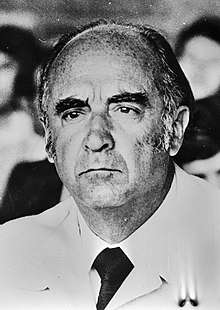
In the 1976 election, the PRI presidential candidate José López Portillo faced no real opposition, not even the National Action Party, which did not field a candidate in this election due to an ideological split. The lack of the appearance of democracy in the national elections undermined the legitimacy of the system. He proposed a reform called Ley Federal de Organizaciones Políticas y Procesos Electorales which gave official registry to opposition groups such as the Mexican Democratic Party and the Mexican Communist Party. This law also created positions in the lower chamber of congress for opposition parties through proportionality of votes, relative majority, uninominal and plurinominal. As a result, in 1979, the first independent (non-PRI) communist deputies were elected to the Congress of Mexico.[84] Within the PRI, party president Carlos Sansores pushed for what he called "transparent democracy", but the effort went nowhere.[71]
Although López Portillo's term started with economic difficulties, the discovery of significant oil reserves in Mexico allowed him to borrow funds from foreign banks to be repaid in dollars against future revenues to allocate funds for social spending immediately. The discovery of significant oil sites in Tabasco and Campeche helped the economy to recover and López Portillo promised to "administer the abundance." The development of the promising oil industry was financed through external debt which reached 59 billion dollars[84] (compared to 25 billion[83] during Echeverría). Oil production increased from 94,000 barrels per day (14,900 m3/d) at the beginning of his administration to 1,500,000 barrels per day (240,000 m3/d) at the end of his administration and Mexico became the fourth largest oil producer in the world.[84] The price for a barrel of oil also increased from three dollars in 1970 to 35 dollars in 1981.[84] The government attempted to develop heavy industry. However, waste became the rule as centralized resource allocation and distribution systems were accompanied by inefficiently located factories incurring high transport costs.
Mexico increased its international presence during López Portillo: in addition to becoming the world's fourth oil exporter, Mexico restarted relations with the post Franco-Spain in 1977, allowed Pope John Paul II to visit Mexico, welcomed American president Jimmy Carter and broke relations with Somoza and supported the Sandinista National Liberation Front in its rebellion against the United States supported government. López Portillo also proposed the Plan Mundial de Energéticos in 1979 and summoned a North-South World Summit in Cancún in 1981 to seek solutions to social problems.[84] In 1979, the PRI founded the COPPPAL, the Permanent Conference of Political Parties of Latin America and the Caribbean, an organization created "to defend democracy and all lawful political institutions and to support their development and improvement to strengthen the principle of self determination of the peoples of Latin America and the Caribbean".[85]
Social programs were also created through the Alliance for Production, Global Development Plan, el COPLAMAR, Mexican Nourishing System, to attain independence on food, to reform public administration. López Portillo also created the secretaries of Programming and Budgeting, Agriculture and Water Resources, Industrial Support, Fisheries and Human Settlements and Public Works. Mexico then obtained high economic growth, a recuperation of salaries and an increase in spending on education and infrastructure. This way, social and regional inequalities started to diminish.[84] The attempted industrialization had not been responsive to consumer needs. Therefore, unprecedented urbanization and overcrowding followed and so, substandard pre-fabricated apartment blocs had to be built in large cities.
All this prosperity ended when the over-supply of oil in early 1982 caused oil prices to plummet and severely damaged the national economy. Interest rates skyrocketed in 1981 and external debt reached 86 billion dollars and exchange rates went from 26 to 70 pesos per dollar and inflation of 100%. This situation became so desperate that Lopez Portillo ordered the suspension on payments of external debt and the nationalization of the banking industry in 1982 consistent with the Socialist goals of the PRI. Capital fled Mexico at a rate never seen before in history. The Mexican government provided subsidies to staple food products and rail travel; this diminished the consequences of the crises on the populace. Job growth stagnated and millions of people migrated North to escape the economic stagnation. López Portillo's reputation plummeted and his character became the butt of jokes from the press.[84] In his last presidential address on September 1, 1982, he nationalized foreign banks. During his campaign, López Portillo promised to defend the peso "como un perro" ("like a dog"),[84] López Portillo refused to devalue the currency[83] saying "The president who devalues, devalues himself."[84]
First of the technocratic presidents, 1982
_(cropped).jpg)
When López Portillo left office in December 1982, the economy was in shambles. He designated Miguel de la Madrid as the PRI candidate, the first of a series of economists to rule the country, a technocrat who turned his back on populist policies to implement neoliberal reforms, causing the number of state-owned industries to decline from 1155 to a mere 412. After the 1982 default, crisis lenders were unwilling to loan Mexico and this resulted in currency devaluations to finance spending. An earthquake in September 1985, in which his administration was criticised for its slow and clumsy reaction, added more woe to the problems. As a result of the crisis, black markets supplied by goods stolen from the public sector appeared. Galloping inflation continued to plague the country, hitting a record high in 1987 at 159.2%.
1988–2000
Left-wing splits from the PRI
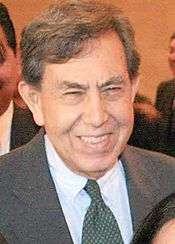
In 1986, Cuauhtémoc Cárdenas (former Governor of Michoacán and son of the former president of Mexico Lázaro Cárdenas) formed the "Democratic Current" (Spanish: Corriente Democrática) of the PRI, which criticized the federal government for reducing spending on social programs to increase payments on foreign debt. The members of the Democratic Current were expelled from the party and formed the National Democratic Front (FDN, Spanish: Frente Democrático Nacional) in 1987. The following year, the FDN elected Cárdenas as presidential candidate for the 1988 presidential election[86] which was won by Carlos Salinas de Gortari, obtaining 50.89% of the votes (according to official figures) versus 32% of Cárdenas. The official results were delayed, with the Secretary of the Interior (until then, the organizer of elections) blaming it on a computer system failure. Cárdenas, who claimed to have won and claimed such computer failure was caused by a manipulation of the system to count votes. Manuel Clouthier of the National Action Party (PAN, Spanish: Partido Acción Nacional) also claimed to have won, although not as vocally.
Miguel de la Madrid, Mexico's president at the time of the 1988 election, admitted in 2004 that, on the evening of the election, he received news that Cárdenas was going to win by a majority, and that he and others rigged the election as a result.[87]
Clouthier, Cárdenas and Rosario Ibarra de Piedra then complained before the building of the Secretary of the Interior.[88] Clouthier and his followers then set up other protests, among them one at the Chamber of Deputies, demanding that the electoral packages be opened. In 1989, Clouthier presented an alternative cabinet (a British style Shadow Cabinet) with Diego Fernández de Cevallos, Jesús González Schmal, Fernando Canales Clariond, Francisco Villarreal Torres, Rogelio Sada Zambrano, María Elena Álvarez Bernal, Moisés Canales, Vicente Fox, Carlos Castillo Peraza and Luis Felipe Bravo Mena as cabinet members and Clouthier as cabinet coordinator. The purpose of this cabinet was to vigilate the actions of the government. Clouthier died next October in an accident with Javier Calvo, a federal deputy. The accident has been claimed by the PAN as a state assassination since then.[89] That same year, the PRI lost its first state government with the election of Ernesto Ruffo Appel as governor of Baja California.
Attempt at internal reform, 1990s
Luis Donaldo Colosio at the time party president attempted a "democratic experiment" to open up the party at the level of candidates for gubernatorial and municipal elections, which would bar precandidates from campaigning for the nomination, but without a democratic tradition within the party and a basic a fact as the lack of lists of party membership meant the experiment failed. Carlos Salinas de Gortari resisted any attempts to reform the party. At the end of 1994, after the assassination of Colosio who had been designated the PRI presidential candidate, the party did move toward greater internal democracy.[90]
Political turmoil and decline of power
In 1990, Peruvian writer Mario Vargas Llosa called the government under the PRI la dictadura perfecta ("the perfect dictatorship").[91] Despite that perception, a major blow came with the assassination of the 1994 PRI candidate Luis Donaldo Colosio, the first high-level assassination since that of president-elect Alvaro Obregón in 1928, which led to Calles forming the PRN to deal with the political vacuum. President Carlos Salinas de Gortari designated Colosio's campaign director, Ernesto Zedillo Ponce de Leon, as the new PRI candidate, who was subsequently elected. The 1994 elections were the first Mexican presidential election monitored by international observers.
A number of factors, including the 1994 economic crisis in Mexico, caused the PRI to lose its absolute majority in both chambers of the federal congress for the first time in 1997.
After several decades in power the PRI had become a symbol of corruption and electoral fraud.[92] The conservative National Action Party (PAN) became a stronger party after 1976 when it obtained the support from businessmen after recurring economic crises.[92] Consequently, the PRI's left wing separated and formed its own party, the Party of the Democratic Revolution (PRD) in 1989.
Critics claim electoral fraud, with voter suppression and violence, was used when the political machine did not work and elections were just a ritual to simulate the appearance of a democracy. However, the three major parties now make the same claim against each other (PRD against Vicente Fox's PAN and PAN vs. López Obrador's PRD, and the PRI against the PAN at the local level and local elections such as the 2007 Yucatán state election). Two other PRI presidents Miguel de la Madrid and Carlos Salinas de Gortari privatized many outmoded industries, including banks and businesses, entered the General Agreement on Tariffs and Trade and also negotiated the North American Free Trade Agreement.
In the final decades of the PRI regime, the connections between the party and drug cartels became more evident, as the drug trade saw a massive increase, which worsened corruption in the party and at all spheres of Government. In 1984, journalist Manuel Buendía was murdered by agents of the Federal Security Directorate (Buendía had been investigating possible ties between Drug cartels, the CIA and the FSD itself).[93] In 1997, general Jesús Gutiérrez Rebollo, who had been appointed by president Ernesto Zedillo as head of the Instituto Nacional de Combate a las Drogas, was arrested after it was discovered that he had been collaborating with the Juárez Cartel.[94] In another infamous incident, Mario Villanueva, a member of the PRI and outgoing governor of Quintana Roo, was accused of drug trafficking charges in 1999. When the evidence against Villanueva became strong enough to warrant an arrest, he disappeared from the public eye two days before the end of his term, being absent at the ceremony at which he was to hand the office over to his elected successor, Joaquín Hendricks Díaz. Villanueva remained a fugitive from justice for many years, until being captured and arrested in 2001.[95]
2000–2012
Loss of the presidency of Mexico
Prior to the 2000 general elections, the PRI held its first primaries to elect the party's presidential candidate. The primary candidates, nicknamed "los cuatro fantásticos" (Spanish for The Fantastic Four), were:[96]
- Francisco Labastida Ochoa (former governor of Sinaloa and Secretary of the Interior)
- Roberto Madrazo Pintado (former governor of Tabasco)
- Manuel Bartlett (former governor of Puebla and Secretary of the Interior)
- Humberto Roque Villanueva
The favorites in the primaries were Labastida and Madrazo, and the latter initiated a campaign against the first, perceived as Zedillo's candidate since many former secretaries of the interior were chosen as candidates by the president. His campaign, produced by prominent publicist Carlos Alazraki, had the motto "Dale un Madrazo al dedazo" or "Give a Madrazo to the dedazo" with "madrazo" being an offensive slang term for a "strike" and "dedazo" a slang used to describe the unilaterally choosing of candidates by the president (literally "finger-strike").
The growth of the PAN and PRD parties culminated in 2000, when the PAN won the presidency, and again in 2006 (won this time by the PAN with a small margin over the PRD.) Many prominent members of the PAN (Manuel Clouthier,[89] Addy Joaquín Coldwell and Demetrio Sodi), most of the PRD (most notably all three Mexico City mayors Andrés Manuel López Obrador, Cuauhtémoc Cárdenas and Marcelo Ebrard), the PVEM (Jorge González Torres) and New Alliance (Roberto Campa) were once members of the PRI, including many presidential candidates from the opposition (Clouthier, López Obrador, Cárdenas, González Torres, Campa and Porfirio Muñoz Ledo, among many others).
In the presidential elections of July 2, 2000, its candidate Francisco Labastida Ochoa was defeated by Vicente Fox, after getting only 36.1% of the popular vote. It was to be the first Presidential electoral defeat of the PRI. In the senatorial elections of the same date, the party won with 38.1%, or 33 out of 128 seats in the Senate of Mexico.
As an opposition party
After much restructuring, the party was able to make a recovery, winning the greatest number of seats (5% short of a true majority) in Congress in 2003: at these elections, the party won 224 out of 500 seats in the Chamber of Deputies, remaining as the largest single party in both the Chamber of Deputies and Senate. In the Federal District the PRI obtained only one borough mayorship (jefe delegacional) out of 16, and no first-past-the-post members of the city assembly. The PRI recouped some significant losses on the state level (most notably, the governorship of former PAN stronghold Nuevo León). On August 6, 2004, in two closely contested elections in Oaxaca and Tijuana, PRI candidates Ulises Ruiz Ortiz and Jorge Hank Rhon won the races for the governorship and municipal presidency respectively. The PAN had held control of the president's office of the municipality of Tijuana for 15 years. Six out of eight gubernatorial elections held during 2005 were won by the PRI: Quintana Roo, Hidalgo, Colima, Estado de México, Nayarit, and Coahuila. The PRI then controlled the states on the country's northern border with the US except for Baja California.
Later that year Roberto Madrazo, president of the PRI, left his post to seek a nomination as the party's candidate in the 2006 presidential election. According to the statutes, the presidency of the party would then go to Elba Esther Gordillo as party secretary. The rivalry between Madrazo and Gordillo caused Mariano Palacios Alcocer instead to become president of the party. After what was perceived an imposition of Madrazo as candidate a group was formed called Unidad Democrática (Spanish: "Democratic Unity"), although nicknamed Todos Unidos Contra Madrazo (Spanish: "Everybody United Against Madrazo" or "TUCOM")[97] which was formed by governors and former state governors:
- Arturo Montiel (former governor of the State of Mexico)
- Enrique Jackson (federal senator)
- Tomás Yarrington (governor of Tamaulipas)
- Enrique Martínez (former governor of Coahuila)
- Manuel Núñez (governor of Hidalgo)
Montiel won the right to run against Madrazo for the candidacy but withdrew when it was made public that he and his French wife had multi-million properties in Europe.[98] Madrazo and Everardo Moreno contended in the primaries which was won by the first.[99] Madrazo then represented the PRI and the Ecologist Green Party of Mexico (PVEM) in the Alliance for Mexico coalition.
During his campaign, Madrazo declared that the PRI and PRD were "first cousins", to this Emilio Chuayffet Chemor responded that if that was the case then Andrés Manuel López Obrador (AMLO), candidate of the PRD would also be a first cousin and he might win the election.[100]
AMLO was, by then, the favorite in the polls, with many followers within the PRI. Madrazo, second at the polls, then released TV spots against AMLO with little success, his campaign was managed again by Alazraki. Felipe Calderón ran a more successful campaign and then tied with Madrazo and later surpassed him as the second favorite. Gordillo, also the teachers' union leader, resentful against Madrazo, helped a group of teachers constitute the New Alliance Party. Divisions within the party and a successful campaign of the PAN candidate caused Madrazo to fall to third place. The winner, as announced by the Federal Electoral Institute and evaluated by the Mexican Election Tribunal amidst a controversy, was Felipe Calderón of the ruling PAN. On November 20 of the same year, a group of young PRI politicians launched a movement that is set to reform and revolutionize the party.[101] The PRI candidate failed to win a single state in the 2006 presidential election.
In the 2006 legislative elections the party won 106 out of 500 seats in the Chamber of Deputies and 35 out of 128 Senators.
In 2007 the PRI re-gained the governorship of Yucatán and was the party with the most mayorships and state congresspeople in the elections in Yucatán (tying with the PAN in the number of deputies), Chihuahua, Durango, Aguascalientes, Veracruz, Chiapas and Oaxaca. The PRI obtained the most mayorships in Zacatecas and the second most deputies in the congressional elections of Zacatecas and Baja California.[102]
In 2009, the PRI re-gained plurality control of Mexican congress. This is the first time congress will be controlled by the PRI since the first initial victory by the opposing party PAN in the year 2000.[103]
The PRI benefited from both the growing unpopularity of Felipe Calderón's administration as President due to the notorious increase in the homicide rate as result of his war on drugs, as well as internal conflicts in the left-wing Partido de la Revolucion Democratica (PRD) that deteriorated its image.
2012–2018
Return of the PRI
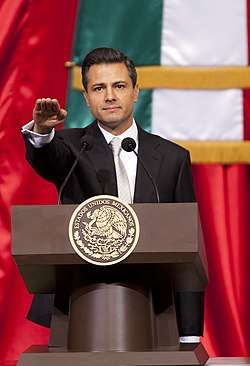
Under Enrique Peña Nieto and after ruling for most of the past century in Mexico, the PRI returned to the presidency as it had brought hopes to those who gave the PRI another chance and fear to those who worry about the old PRI tactics of making deals with the cartels in exchange for relative peace.[104] According to an article published by The Economist on June 23, 2012, part of the reason why Peña Nieto and the PRI were voted back to the presidency after a 12-year struggle lies in the disappointment of the ruling of the PAN.[105] Buffeted by China's economic growth and the economic recession in the United States, the annual growth of Mexico's economy between 2000 and 2012 was 1.8%. Poverty exacerbated, and without a ruling majority in Congress, the PAN presidents were unable to pass structural reforms, leaving monopolies and Mexico's educational system unchanged.[105] In 2006, Felipe Calderón chose to make the battle against organized crime the centerpiece of his presidency. Nonetheless, with over 60,000 dead and a lack of any real progress, Mexican citizens became tired of a fight they had first supported, and not by majority.[105] The Economist alleged that these signs are "not as bad as they look," since Mexico is more democratic, it enjoys a competitive export market, has a well-run economy despite the crisis, and there are tentative signs that the violence in the country may be plummeting. But if voters want the PRI back, it is because "the alternatives [were] weak".[105] The newspaper also alleges that Mexico's preferences should have gone left-wing, but the candidate that represented that movement – Andrés Manuel López Obrador – was seen with "disgraceful behaviour". The conservative candidate, Josefina Vázquez Mota, was deemed worthy but was considered by The Economist to have carried out a "shambolic campaign". Thus, Peña Nieto wins by default, been considered by the newspaper as the "least bad choice" for reform in Mexico.[105]
Aftermath of the return of the PRI
When it was tossed from the presidency in the year 2000, few expected that the "perfect dictatorship", a description coined by Mario Vargas Llosa, would return again in only 12 years.[106] Associated Press published an article in July 2012 noting that many immigrants living in the United States were worried about the PRI's return to power and that it could dissuade many from returning to their homeland.[107] The vast majority of the 400,000 voters outside of Mexico voted against Peña Nieto, and said they were "shocked" that the PRI – which largely convinced them to leave Mexico – had returned.[107] Voters that favored Peña Nieto, however, believed that the PRI "had changed" and that more jobs would be created under the new regime.[108] Moreover, some U.S. officials were concerned that Peña Nieto's security strategy meant the return to the old and corrupt practices of the PRI regime, where the government made deals and turned a blind eye on the cartels in exchange for peace.[109] After all, they worried that Mexico's drug war, which had already cost over 50,000 lives, would make Mexicans question on why they should "pay the price for a US drug habit".[109] Peña Nieto denied, however, that his party would tolerate corruption, and stated he would not make deals with the cartels.[109] In spite of Peña's words, a poll from September 20, 2016, revealed that 83% of Mexican citizens perceived the PRI as the most corrupt political party in Mexico.[110]
The return of the PRI brought some perceived negative consequences, among them:
- Low levels of presidential approval of EPN and allegations of presidential corruption: The government of president of Mexico Enrique Peña Nieto (EPN) has faced multiple scandals and allegations of corruption. Reforma, who has run a surveys of presidential approval since 1995, revealed EPN had received the lowest presidential approval in modern history since they started surveying about it in 1995. Revealed EPN had received a mere 12% approval rating. The lowest since they started to survey for presidential approval, the second lowest approval was for the Ernesto Zedillo (1994-2000) also from the PRI. While also revealing both presidents elected from National Action Party (PAN), Vicente Fox (2000-2006) and Felipe Calderon (2006-2012), both had higher presidential approvals than the PRI presidents.[111]
- PRI corrupt ex-governors declared criminals by the Mexican government: During EPN's government multiple members of the PRI political party have been declared criminals by the Mexican government, specially alarming the fact that many of those PRI members in fact campaigned with the PRI, and in fact where elected as state governors within the Mexican government, among those are: the aforementioned Tomas Yarrington from Tamaulipas (along his predecessor Eugenio Hernandez Flores), Javier Duarte from Veracruz,[112] César Duarte Jáquez from Chihuahua[113] (no family relation between both Duarte), and Roberto Borge from Quintana Roo, along their unknown multiple allies who enabled their corruption.[114] All those supported (or campaigned for state governors) EPN during his presidential campaign.[115][116][117]
- State of Mexico allegations of electoral fraud (2017): The 2017 elections within the state of Mexico were highly controversial, with multiple media outlet feeling there was electoral fraud committed by the PRI. In November 2017, magazine Proceso published an article accusing the PRI of breaking at least 16 state laws during the elections, which were denounced 619 times. They said that all of them were broken in order to favor PRI candidate for governor Alfredo del Mazo (whom is the cousin of Enrique Peña Nieto and whom several of his relatives have also been governors of said entity). The article claims it has been the most corrupt election in modern Mexican history, and directly blames the PRI. Despite all the evidence, Alfredo del Mazo was declared winner of the election by the electoral tribunals, and is currently serving as governor.[118]
The Chamber of Deputies also suffered from controversies from members of the PRI:
- Law 3 of 3 Anticorruption controversy: In early 2016, a controversy arose when all the Senate disputes from the PRI, voted against the "Ley 3 de 3 (Law 3 of 3)". A law that would have obligated every politician to declare three things: make an obligatory public patrimonial declaration, interests declaration, and fiscal. A light version of the law was accepted but it doesn't oblige politicians to declare.[119][120] While it was completely legal for the deputies from the PRI, to vote against such law, some news media outlets interpreted the votes against the promulgation of such law as the political party protecting itself from the findings that could surface if such declarations were to be made.[121][122]
- In November 2017, Aristegui Noticias reported that "the PRI and their allies were seeking to approve the "Ley de Seguridad Interior (Law of Internal Security)". Whom the Mexican National Human Rights Commission (CNDH) had previously said, that it violated Human Rights, because it favors the discretional usage of the army forces. Endangering citicenz by giving a blank check to the army" and the president, to order an attack towards any group of people they consider a danger without requiring an explanation. This could include people such as social activists.[123][124]
2018 presidential election
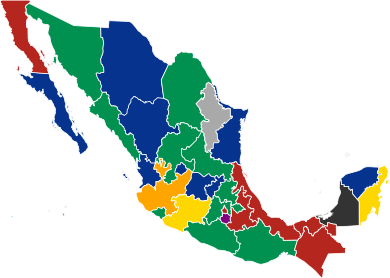
On November 27, 2017, José Antonio Meade announced he would compete in the 2018 presidential election, representing the PRI. He has been reported to have been handpicked directly by president Enrique Peña Nieto through the traditional and now controversial practice known as El Dedazo (the literal translation would be "The big finger", the slang phrase regards towards the incumbent president directly pointing towards his successor).[125][126]
There were concerns about the possibility of fraud in the presidential election following allegations of electoral fraud concerning the election of Enrique Peña Nieto's cousin Alfredo del Mazo Maza as governor of the state of Mexico, in December 2017. The Mexican newspaper Regeneración, which is officially linked to the MORENA party, warned about the possibility of the PRI committing an electoral fraud. Cited was the controversial law of internal security that the PRI senators approved as the means to diminish the protests towards such electoral fraud.[127] Bloomberg News also supported that possible outcome, with Tony Payan, director of the Houston's Mexico Center at Rice University's Baker Institute, suggesting that both vote buyout and computer hackings were possible, citing the 1988 previous electoral fraud committed by the PRI. Bloomberg's article also suggested Meade could also receive unfair help from the over-budget amounts of money spent in publicity by incumbent president Enrique Peña Nieto (who also campaigned with the PRI).[128] A December 2017 article in The New York Times reported Peña Nieto spending about 2,000 million dollars on publicity during his first 5 years as president, the largest publicity budget ever spent by a Mexican President. Additionally, the article noted concerns of news journalists, 68 percent of whom claimed to not believe they have enough freedom of speech. To support the statement, the cited award-winning news reporter Carmen Aristegui, who was controversially fired shortly after revealing the Mexican White House scandals concerning a conflict of interest regarding a house owned by Peña Nieto.[129]
In April 2018, Forbes published the British news program Channel 4 News story claiming the existence of proof of ties between the PRI and Cambridge Analytica, implicated in Russian meddling in the 2016 U.S. presidential election, suggesting a "modus operandi" in Mexico similar to the one in the United States. The information indicated they worked together at least until January 2018.[130][131][132] An investigation was requested.[133] The PRI has denied ever contracting Cambridge Analytica.[134] The New York Times acquired the 57-page proposal of Cambridge Analytica's outlining a strategy of collaboration to benefit the PRI by hurting MORENA's candidate Andrés Manuel López Obrador. The political party rejected Cambridge Analytica's offer but paid the firm to not help the other candidates.[135]
In the 2018 general election, the PRI suffered a monumental legislative defeat, scoring the lowest number of seats in the party's history. Presidential candidate José Antonio Meade also only scored 16.4% of the votes, finishing in third place, while the party only managed to elect 42 deputies (down from 203 of 2015) and 14 senators (down from 61 in 2012).
The PRI was also defeated on each of the 9 elections for state governors where the National Regeneration Movement won 4, PAN 3, and Social Encounter Party and Citizens' Movement each with 1.[136]
Electoral history
Presidential elections 1929–2018
| Election year | Candidate | Votes | % | Outcome | Notes |
|---|---|---|---|---|---|
| 1929 | Pascual Ortiz Rubio | 1,947,848 | 93.6 | As PNR, first election after the formation of the party. The opposition candidate José Vasconcelos claimed victory for himself and refused to recognize the official results, claiming that the elections were rigged; then he unsuccessfully attempted to organize an armed revolt. He was jailed and later exiled to the United States. Former President Plutarco Elías Calles (1924-1928) and party founder removed Ortiz Rubio from the presidency, replacing him with Abelardo L. Rodríguez in 1932. | |
| 1934 | Lázaro Cárdenas | 2,225,000 | 98.2 | As PNR. Revolutionary general. First president to serve a six-year term; chosen by Calles as party candidate | |
| 1940 | Manuel Ávila Camacho | 2,476,641 | 93.9 | As PRM. Revolutionary general. The opposition candidate Juan Andreu Almazán refused to recognize the official results, claiming that a massive electoral fraud had taken place. He later fled to Cuba and unsuccessfully tried to organize an armed revolt. | |
| 1946 | Miguel Alemán Valdés | 1,786,901 | 77.9 | First civilian president since the Mexican Revolution. Son of revolutionary general Miguel Alemán González. | |
| 1952 | Adolfo Ruiz Cortines | 2,713,419 | 74.3 | The opposition candidate Miguel Henríquez Guzmán claimed victory and refused to recognize the official results, claiming that a massive electoral fraud had taken place. | |
| 1958 | Adolfo López Mateos | 6,767,754 | 90.4 | ||
| 1964 | Gustavo Díaz Ordaz | 8,368,446 | 88.8 | ||
| 1970 | Luis Echeverría Álvarez | 11,970,893 | 86.0 | ||
| 1976 | José López Portillo | 16,727,993 | 100.0 | Unopposed | |
| 1982 | Miguel de la Madrid | 16,748,006 | 74.3 | ||
| 1988 | Carlos Salinas de Gortari | 9,687,926 | 50.7 | Son of PRI official Raúl Salinas Lozano. Lowest percentage of voters to date. All of the opposition parties claimed that the election was rigged and refused to recognize the official results; Cuauhtémoc Cárdenas and Manuel Clouthier both claimed victory. | |
| 1994 | Ernesto Zedillo | 17,181,651 | 48.6 | Chosen the PRI candidate after the 23 March 1994 assassination of Luis Donaldo Colosio | |
| 2000 | Francisco Labastida | 13,579,718 | 36.1 | First PRI presidential candidate chosen by a primary | |
| 2006 | Roberto Madrazo | 9,301,441 | 22.2 | Coalition: Alliance for Mexico. Candidate is son of reformist PRI politician Carlos A. Madrazo | |
| 2012 | Enrique Peña Nieto | 19,226,284 | 38.2 | Coalition: Commitment to Mexico | |
| 2018 | José Antonio Meade | 9,289,378 | 16.4 | Coalition: Todos por México |
Congressional elections
Chamber of Deputies
| Election year | Constituency | PR | No. of seats | Position | Presidency | Note | |||
|---|---|---|---|---|---|---|---|---|---|
| Votes | % | Votes | % | ||||||
| 1940 | 172 / 173 |
Majority | Manuel Ávila Camacho | ||||||
| 1946 | 1,687,284 | 73.5 | 141 / 147 |
Majority | Miguel Alemán Valdés | ||||
| 1952 | 2,713,419 | 74.3 | 151 / 161 |
Majority | Adolfo Ruiz Cortines | ||||
| 1958 | 6,467,493 | 88.2 | 153 / 162 |
Majority | Adolfo López Mateos | ||||
| 1964 | 7,807,912 | 86.3 | 175 / 210 |
Majority | Gustavo Díaz Ordaz | ||||
| 1970 | 11,125,770 | 83.3 | 175 / 210 |
Majority | Luis Echeverría Álvarez | ||||
| 1976 | 12,868,104 | 85.0 | 195 / 237 |
Majority | José López Portillo | ||||
| 1982 | 14,501,988 | 69.4 | 14,289,793 | 65.7 | 299 / 400 |
Majority | Miguel de la Madrid | ||
| 1988 | 9,276,934 | 51.0 | 9,276,934 | 51.0 | 260 / 500 |
Majority | Carlos Salinas de Gortari | ||
| 1991 | 14,051,349 | 61.4 | 14,145,234 | 61.4 | 320 / 500 |
Majority | Carlos Salinas de Gortari | ||
| 1994 | 16,851,082 | 50.2 | 17,236,836 | 50.3 | 300 / 500 |
Majority | Ernesto Zedillo | ||
| 1997 | 11,305,957 | 39.1 | 11,438,719 | 39.1 | 239 / 500 |
Minority | Ernesto Zedillo | ||
| 2000 | 13,720,453 | 36.9 | 13,800,306 | 36.9 | 207 / 500 |
Minority | Vicente Fox | ||
| 2003 | 6,166,358 | 23.9 | 6,196,171 | 24.0 | 224 / 500 |
Minority | Vicente Fox | ||
| 2006 | 11,629,727 | 28.0 | 11,689,110 | 27.9 | 121 / 500 |
Minority | Felipe Calderón | Coalition: Alliance for Mexico | |
| 2009 | 12,765,938 | 36.9 | 12,809,365 | 36.9 | 241 / 500 |
Minority | Felipe Calderón | ||
| 2012 | 15,166,531 | 31.0 | 15,513,478 | 31.8 | 212 / 500 |
Minority | Enrique Peña Nieto | Coalition: Commitment to Mexico | |
| 2015 | 11,604,665 | 34.2 | 11,638,556 | 29.2 | 203 / 500 |
Minority | Enrique Peña Nieto | Coalition: Commitment to Mexico | |
| 2018 | 4,351,824 | 7.78 | 9,310,523 | 16.54 | 45 / 500 |
Minority | Andrés Manuel López Obrador | Coalition: Todos por México | |
Senate elections
| Election year | Constituency | PR | No. of seats | Position | Presidency | Note | |||
|---|---|---|---|---|---|---|---|---|---|
| Votes | % | Votes | % | ||||||
| 1964 | 7,837,364 | 87.8 | 64 / 64 |
Majority | Gustavo Díaz Ordaz | ||||
| 1970 | 11,154,003 | 84.4 | 64 / 64 |
Majority | Luis Echeverría Álvarez | ||||
| 1976 | 13,406,825 | 87.5 | 64 / 64 |
Majority | José López Portillo | ||||
| 1982 | 63 / 64 |
Majority | Miguel de la Madrid | ||||||
| 1988 | 9,263,810 | 50.8 | 60 / 64 |
Majority | Carlos Salinas de Gortari | ||||
| 1994 | 17,195,536 | 50.2 | 95 / 128 |
Majority | Ernesto Zedillo | ||||
| 1997 | 11,266,155 | 38.5 | 77 / 128 |
Majority | Ernesto Zedillo | ||||
| 2000 | 13,699,799 | 36.7 | 13,755,787 | 36.7 | 51 / 128 |
Minority | Vicente Fox | ||
| 2006 | 11,622,012 | 28.1 | 11,681,395 | 28.0 | 39 / 128 |
Minority | Felipe Calderón | Coalition: Alliance for Mexico | |
| 2012 | 18,477,441 | 37.0 | 18,560,755 | 36.9 | 61 / 128 |
Minority | Enrique Peña Nieto | Coalition: Commitment to Mexico | |
| 2018 | 3,855,984 | 6.86 | 9,013,658 | 15.90 | 13 / 128 |
Minority | Andrés Manuel López Obrador | Coalition: Todos por México | |
Controversies
Vote-buying
Due to weak law enforcement and weak political institutions, vote-buying and electoral fraud are a phenomenon that typically does not see any consequences. As a result of a pervasive, tainted electoral culture, vote buying is common among major political parties that they sometimes reference the phenomenon in their slogans, "Toma lo que los demás dan, ¡pero vota Partido Accion Nacional!" (English: Take what the others give, but vote National Action Party!)[137][138]
In popular culture
Film depiction
The 1999 film Herod's Law, directed by Luis Estrada, is a political satire of corruption in Mexico under the PRI regime. It was notably the first film to criticize the PRI explicitly by name[139] and carried some controversy and censorship attempts from the Mexican government because of it.
A latter Estrada film, The Perfect Dictatorship (2014), dealt with the political favoritism of Televisa towards the PRI, and the concept of the "cortinas de humo (smoke screens)" was explored in the Mexican black-comedy film, whose plot directly criticizes both the PRI and Televisa.[140] Taking place in a Mexico with a tightly controlled media landscape, the plot centers around a corrupt politician (a fictional stand-in for Enrique Peña Nieto) from a political party (serving as a fictional stand-in for the PRI), and how he makes a deal with TV MX (which serves as a stand-in to Televisa) to manipulate the diffusion of news towards his benefit, in order to save his political career.[141] The director made it based on the perceived media manipulation in Mexico.[142]
References
- José Antonio Aguilar Rivera (August 31, 2016). "Nota sobre el nacionalismo claudicante". Nexos.
- Laura Rojas (August 17, 2014). "La muerte del nacionalismo revolucionario". Excélsior.
- Juan Jose de la Cruz Arana (February 16, 2012). "Autoridad y Memoria: El Partido Revolucionario Institucional". Distintas Latitudes.
- Carlos Báez Silva (May 2001). El Partido Revolucionario Institucional. Algunas Notas sobre su Pasado Inmediato para su Comprensión en un Momento de Reorientación. Los Años Recientes (PDF). Convergencia. pp. 5, 6. ISSN 1405-1435.
- Daniel Bonilla Maldonado (April 18, 2016). El constitucionalismo en el continente americano. Siglo del Hombre. pp. 2019, 220.
- Francisco Paoli Bolio (2017). Constitucionalismo en el siglo XXI (PDF). Instituto Nacional de Estudios Históricos de las Revoluciones de México.
- "Castro Trenti repudia matrimonios "gay"; protesta lo hace recular" (in Spanish).
- "PRI en contra del matrimonio igualitario" (in Spanish).
- "Arriola reitera rechazo a adopción homoparental pese a críticas" (in Spanish). Forbes.
- Graham, Dave (4 July 2018). "RIP PRI? Mexico's ruling party in 'intensive care' after drubbing". Reuters. Retrieved 10 July 2018.
- Jon Vanden Heuvel, Everette E. Dennis, ed. (1995). Changing Patterns: Latin America's Vital Media : a Report of The Freedom Forum Media Studies Center at Columbia University in the City of New York. p. 20.
- Niko Vorobyov, ed. (2019). Dopeworld: Adventures in Drug Lands. Hachette UK.
... Mexico spent most of the twentieth century governed by the Institutional Revolutionary Party or PRI, a bigtent, catch-all alliance that included everyone ...
- Bruhn, Kathleen (2008), Urban Protest in Mexico and Brazil, Cambridge University Press, p. 18
- Storrs, K. Larry (2005), "Mexico-U.S. Relations", Mexico: Migration, U.S. Economic Issues and Counter Narcotic Efforts, Stanford University Press, p. 56
- Samuels, David J.; Shugart, Matthew S. (2010), Presidents, Parties, and Prime Ministers: How the Separation of Powers Affects Party Organization and Behavior, Cambridge University Press, p. 141
- "Full Member Parties". Socialist International. Retrieved 11 January 2016.
- "Meade, the King of the Mexican Sandwich". El Universal. January 11, 2018.
- Russell, James W. (2009). Class and Race Formation in North America. University of Toronto Press. p. 155. ISBN 978-0-8020-9678-4.
- Kopstein, Jeffrey; Lichbach, Mark; Hanson, Stephen E. (July 21, 2014). Comparative Politics: Interests, Identities, and Institutions in a Changing Global Order. Cambridge University Press. Retrieved April 6, 2018.
- El País (Madrid). 1990 September 1. Vargas Llosa: "México es la dictadura perfecta" Archived October 24, 2011, at the Wayback Machine
- MacLeod, Dag (2005). Downsizing the State: Privatization and the Limits of Neoliberal Reform in Mexico. Penn State Press. pp. 37–38. ISBN 0-271-04669-4.
- Bay, Austin (July 4, 2012). "A New PRI or the Old PRI in Disguise?". Real Clear Politics. Retrieved January 31, 2017.
- Jackson, Allison (July 1, 2012). "Mexico elections: Voters could return Institutional Revolutionary Party to power". Global Post. Retrieved 7 July 2012.
- Gallo, Rubén (2004). New Tendencies in Mexican Art: The 1990s. New York: Palgrave Macmillan. pp. 135–136. ISBN 9781403982650. Retrieved December 13, 2015.
- Garrido, Luis Javier, “Partido Revolucionario Institucional (PRI)” in Encyclopedia of Mexico. Chicago: Fitzroy Dearborn 1997, p. 1059.
- Castañeda, Jorge G. Perpetuating Power: How Mexican Presidents Were Chosen. New York: The New Press 2000, p 74
- Preston, Julia and Samuel Dillon, Opening Mexico: The Making of a Democracy. New York: Farrar, Straus and Giroux 2004, p. 56
- Benjamin, Thomas. "Rebuilding the Nation" in The Oxford History of Mexico. New York: Oxford University Press 2000, p. 471-75.
- Garrido, Luis Javier, "Partido Revolucionario Institucional (PRI)" in Encyclopedia of Mexico. Chicago: Fitzroy Dearborn 1997, p. 1058
- Padgett, Vincent Leon, Popular Participation in the Mexican 'One-Party System'. Evanston: Northwestern University Press 1955.
- Ames, Barry. "Bases of Support for Mexico's Dominant Party." American Political Science Review 64 (March 1970).
- "Discurso de Plutarco Elías Calles al abrir las sesiones ordinarias del Congreso. Informe Presidencial". Memoria Política de México. Retrieved 20 July 2020.
- Grayson, George, Mexico" From Corporatism to Pluralism?. Fort Worth: Harcourt Brace College Publishers 1998, p. 18
- Preston and Dillon, Opening Mexico, p. 50.
- Garrido, Javier Luis. El Partido de la Revolución Institucionizada. Mexico City: Siglo XXI p. 103.
- Buchenau, Jürgen. Plutarco Elías Calles and the Mexican Revolution. Lanham: Rowman & Littlefield 2007, 149.
- Buchenau,Plutarco Elías Calles, p.150
- quoted in Buchenau,Plutarco Elías Calles, p.150
- Buchenau,Plutarco Elías Calles, p.151
- Krauze, Enrique. Mexico: Biography of Power. pp. 429-31
- "The Mexican Revolution - Consolidation (1920–40) Part 2". Mexconnect. October 9, 2008.
- "The Foundation of the PRI". mx.geocities.com (in Spanish). October 13, 2000. Archived from the original on October 19, 2009.
- Camp, Roderic Ai. Politics in Mexico, 5th edition. Oxford University Press 2007, p. 137
- Charles H. Weston, Jr. “The Political Legacy of Lázaro Cárdenas”, The Americas vol. 39, no. 3 (Jan. 1963).
- Camp, Politics in Mexico, p. 150
- Aguilar García, Javier, "Luis Napoleón Morones," in Encyclopedia of Mexico, p. 953. Chicago: Fitzroy and Dearborn 1997, p. 953
- Carr, Barry. "Vicente Lombardo Toledano" in Encyclopedia of Mexico. Chicago: Fitzroy Dearborn 1997, pp.754-56
- Fidel Velázquez obituary https://web.archive.org/web/20050217055354/http://ueinternational.org/vol2spec.html
- Camp, Politics in Mexico, pp. 154-55
- Stanford, Lois, "Confederación Nacional Campesina (CNC)" in Encyclopedia of Mexico.Chicago: Fitzroy Dearborn 1997, pp. 286-289.
- Davis, Diane, "Confederación Nacional de Organizaciones Populares" (CNOP). Chicago: Fitzroy Dearborn 1997, pp. 289-94.
- quoted in Edwin Lieuwen, Mexican Militarism: The Political Rise and fall of the Revolutionary Army, 1919–1940. Albuquerque: University of New Mexico Press, 1968. p. 114.
- Weston, “Political Legacy of Lázaro Cárdenas”, p. 395.
- Garrido, "Partido Revolucionario Institucional (PRI)", p. 1058.
- Weston, "The Political Legacy of Lázaro Cárdenas", p. 400, fn. 53 quoting Brandenburg, Frank. The Making of Modern Mexico, p. 93.
- Lucas, Jeffrey Kent (2010). The Rightward Drift of Mexico’s Former Revolutionaries: The Case of Antonio Díaz Soto y Gama. Lewiston, NY: Edwin Mellen Press. pp. 171–203. ISBN 978-0-7734-3665-7.
- Smith, "Mexico Since 1946", p. 335.
- quoted in Garrido,"Partido Revolucionario Institucial (PRI)", p. 1058.
- Garrido,"Partido Revolucionario Institucional (PRI)", p. 1059.
- Smith, "Mexico Since 1946", p. 343.
- Preston and Dillon, Opening Mexico, pp. 53-54.
- Crandall, R. (2004). "Mexico's Domestic Economy". In Crandall, Russell; Paz, Guadalupe; Roett, Riordan (eds.). Mexico's Democracy at Work: Political and Economic Dynamics. Boulder, Colorado: Lynne Reiner Publishers. ISBN 978-1-58826-300-1.
- Smith, Peter H. "Mexico Since 1946" in Mexico Since Independence, Leslie Bethell, ed. New York: Cambridge University Press 1991, pp. 329-32
- Smith, "Mexico Since 1946", p. 334.
- Julia Preston; Samuel Dillon (2005). Opening Mexico: The Making Of A Democracy. Macmillan. pp. 54–184. ISBN 978-0-374-52964-2.
- Smith, "Mexico Since 1946" pp. 334-35
- Smith, "Mexico Since 1946" pp. 336-37.
- Castañeda, V. Émilio. “‘The Death of Artemio Cruz': The False Gods and the Death of Mexico." The Centennial Review, vol. 30, no. 2, 1986, pp. 139–147. JSTOR, https://www.jstor.org/stable/23738707 accessed 10 April 2019.
- Smith, "Mexico Since 1946", p. 344.
- Garrido, "Partido Revolucionario Institucional (PRI)", p. 1060.
- Sherman, John. "The Mexican 'Miracle' and Its Collapse" in The Oxford History of Mexico, Michael Meyer and William Beezley. New York: Oxford University Press 2000, p.598
- Smith, "Mexico Since 1946" p. 359.
- Sherman, "The Mexican 'Miracle' and its Collapse," pp. 598-602
- Doyle, Kate (October 10, 2003). "The Tlatelolco Massacre". National Security Archive.
- "Documents link past presidents to CIA". El Universal. 20 October 2006. Archived from the original on 23 January 2009.
- "1968: Student riots threaten Mexico Olympics". BBC News. October 2, 1968.
- Camp, Roderic Ai. "The Time of the Technocrats and Deconstruction of the Revolution" in The Oxford History of Mexico, Michael Meyer and William Beezley, eds. New York: Oxford University Press 2000, pp. 610-11
- Smith, "Mexico Since 1946", p. 361
- Young, Dolly J. "Mexican Literary Reactions to Tlatelolco 1968". Latin American Research Review, 20, no 2. (1985), 71-85
- Schmidt, Samuel. "Luis Echeverría" in Encyclopedia of Mexico. Chicago: Fitzroy Dearborn 1997, p. 427.
- Schmidt, Henry (Summer 1985). "The Mexican Foreign Debt and the Sexennial Transition from López Portillo to de la Madrid". Mexican Studies. 1 (2): 227–285.
- Doyle, Kate (March 14, 2004). "Prelude to Disaster: José López Portillo and the Crash of 1976". National Security Archive.
- "Biography of José López Portillo". Memoria Política de México.
- "¿Qué es la COPPPAL?". COPPPAL.org (in Spanish).
- "Cuauhtémoc Cárdenas Solórzano". Encyclopædia Britannica.
- Thompson, Ginger (9 March 2004). "Ex-President in Mexico Casts New Light on Rigged 1988 Election". The New York Times.
- Rascón, Marco (18 July 2006). "1988". La Jornada (in Spanish).
- "Biography of Manuel Clouthier". Memoria Política de México.
- Garrido, "Partido Revolucionario Institucional (PRI)", p. 1061.
- "Vargas Llosa: "México es la dictadura perfecta"". El País (in Spanish). 1 September 1990.
- "Partido Revolucionario Institucional". NNDB. Retrieved April 6, 2018.
- Becerril, Andres. "El de Buendía, el primer crimen de narcopolítica". Excelsior. Retrieved 10 July 2018.
- "Cartel worker reportedly spied on DEA in Mexico - CNN.com". 2008-10-29. Archived from the original on 2008-10-29.
- Mario Villanueva Madrid Case Archived 5 April 2011 at the Wayback Machine
- "Los "cuatro fantásticos" del PRI, listos para las urnas". El Mundo (in Spanish). 4 November 1999. Archived from the original on 23 January 2009.
- "Integrantes del Tucom, de políticos pobres a precandidatos que gastan millones". La Jornada (in Spanish). 25 July 2005. Archived from the original on 29 June 2011.
- "Montiel deja vía libre a Madrazo". El Universal (in Spanish). October 21, 2005.
- "Madrazo Set to Win PRI Presidential Primary". Los Angeles Times. November 14, 2005.
- "AMLO, "primo hermano": Chuayffet". La Jornada (in Spanish). March 15, 2006.
- "El Movimiento". elmovimiento.org. Archived from the original on October 12, 2007. Retrieved January 24, 2020.
- "Concluye cómputo municipal y distrital en Chiapas". El Universal (in Spanish). 12 October 2007.
- "Mexico's ruling party loses midterm elections". CNN. July 7, 2009. Retrieved May 5, 2010.
- Sanchez, Raf (2 July 2012). "Mexico elections: Enrique Peña Nieto pledges a new era". The Daily Telegraph. London. Retrieved 3 July 2012.
- "Mexico's presidential election: Back to the future". The Economist. 23 June 2012. Retrieved 3 July 2012.
- "Mexico's election: The PRI is back". The Economist. 2 July 2012. Retrieved 7 July 2012.
- Watson, Julie (July 2, 2012). "Immigrants express shock at return of Mexico's PRI". The Huffington Post. Retrieved January 31, 2017.
- Castillo, E. Eduardo; Corcoran, Katherine (1 July 2012). "Mexico Elections: PRI Could Return To Power With Pena Nieto As President". The Huffington Post. Archived from the original on 2 April 2014.
- Carroll, Rory (2 July 2012). "US concerned Mexico's new president may go easy on drug cartels". The Guardian. London. Retrieved 3 July 2012.
- Digital, Milenio. "PRI, el más corrupto según encuesta de percepción". milenio.com. Retrieved April 6, 2018.
- Ortiz, Erik (August 31, 2016). "Why Mexican President Enrique Peña Nieto is so unpopular". NBC News. Retrieved April 6, 2018.
- McDonnell, Patrick J. "Former governor of Mexico's Veracruz state extradited from Guatemala to face corruption charges". Los Angeles Times. Retrieved April 6, 2018.
- "Mexico: Ex-governor flees to Texas to evade corruption allegations". The Dallas Morning News. March 30, 2017. Retrieved April 6, 2018.
- "PGR e Interpol capturan a Roberto Borge en Panamá". El Universal. June 5, 2017. Retrieved April 6, 2018.
- "Corrupción envuelve a 11 exgobernadores". Excélsior. April 17, 2017. Retrieved April 6, 2018.
- Malkin, Elisabeth (April 19, 2017). "En México se acumulan los gobernadores corruptos, e impunes". The New York Times (in Spanish). Retrieved April 6, 2018.
- "Conoce a los 11 exgobernadores más corruptos de México". Regeneracion.mx. April 17, 2017. Retrieved April 6, 2018.
- ""Ni libre, ni auténtica", la elección en Edomex: Ni un Fraude Más". Proceso. November 16, 2017. Retrieved April 6, 2018.
- "Discusión en el senado". Ley 3de3. Retrieved April 6, 2018.
- "Aprueba el Senado versión 'light' de la 'Ley 3 de 3'". La Jornada (in Spanish). 15 June 2016.
- "Ley #3de3 avanza en comisiones del Senado; PAN vota a favor". El Financiero (in Spanish). 14 June 2016.
- "Nuevamente el PRI vota en contra de de los ciudadanos: PAN BCS". El Informante - Baja California Sur (in Spanish). 18 June 2016.
- "Aristegui Noticias on Twitter". twitter.com. Retrieved April 6, 2018.
- "Más poder al Presidente y a las Fuerzas Armadas: las entrañas de la Ley de Seguridad Interior". Aristegui Noticias.com. Retrieved April 6, 2018.
- "Meade es el dedazo de siempre, dice Barrales". El Universal. November 27, 2017. Retrieved April 6, 2018.
- "Código Alfa: La estrategia del dedazo en la precandidatura de Meade". SDP Noticias.com. December 4, 2017. Retrieved April 6, 2018.
- "PRI prepara un fraude electoral en 2018, alertan académicos y expertos". Regeneracion.mx. December 25, 2017. Retrieved April 6, 2018.
- "Mexico's Presidential Election Could Get Really Dirty". Bloomberg.com. December 18, 2017. Retrieved April 6, 2018.
- Ahmed, Azam (December 25, 2017). "Con su enorme presupuesto de publicidad, el gobierno mexicano controla los medios de comunicación". The New York Times (in Spanish). Retrieved April 6, 2018.
- Staff, Forbes (March 30, 2018). "Cambridge Analytica trabajó con el PRI: Channel 4 News • Forbes México". forbes.com.mx.
- Murillo, Javier. "Cambridge Analytica, sigan la ruta del dinero". elfinanciero.com.mx.
- Peinado, Fernando; Palomo, Elvira; Galán, Javier (March 22, 2018). "The distorted online networks of Mexico's election campaign" – via elpais.com.
- "Exigen al INAI investigar a Cambridge Analytica, Facebook y desarrolladoras de Apps en México - Proceso". proceso.com.mx. April 2, 2018.
- "Niega PRI haber contratado a Cambridge Analytica". Excélsior. March 31, 2018.
- Ahmed, Azam; Hakim, Danny (June 24, 2018). "Mexico's Hardball Politics Get Even Harder as PRI Fights to Hold On to Power" – via NYTimes.com.
- "El PRI se queda sin nada: Morena gana 5 gubernaturas y el PAN 3". Animal Político. July 2, 2018.
- Linthicum, Kate. "In Mexico, voters are wooed with gift cards, washing machines and cheap tortillas". latimes.com.
- "La compra del voto en México". Excélsior. May 24, 2017.
- Crow, Jonathan. "La Ley de Herodes (2000) - Luis Estrada | Synopsis, Characteristics, Moods, Themes and Related". AllMovie (synopsis). All Media Network. Retrieved July 1, 2016.
The first film to criticize the PRI by name...
- Maraboto, Mario (28 October 2014). "'La dictadura perfecta': más allá de la película". Forbes Mexico.
- Ríos, Sandra. "Mexican Film 'La dictadura perfecta' ("The Perfect Dictatorship") Depicts Mexican Reality". Atención San Miguel.
- Linthicum, Kate (November 3, 2014). "Mexican filmmaker Luis Estrada's satirical agenda hits home". Los Angeles Times. Retrieved April 6, 2018.
Further reading
- Camp, Roderic A. “Mexican Presidential Candidates: Changes & Portents for the Future.” Polity, vol. 16, no. 4, 1984, pp. 588–605, JSTOR.
- Smith, Peter H. "Mexico Since 1946" in Mexico Since Independence, Leslie Bethell, ed. New York: Cambridge University Press, 1991.
External links
| Wikimedia Commons has media related to Institutional Revolutionary Party (PRI). |
- Official website

- "Mexican Democracy's Lost Years" (The New York Times)